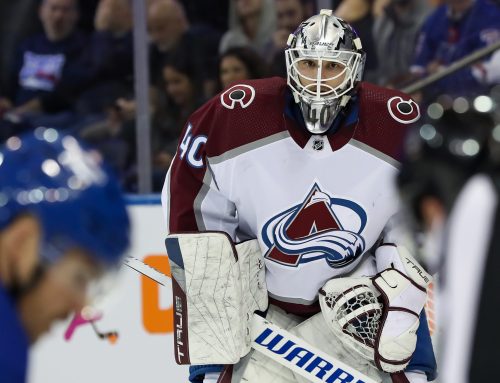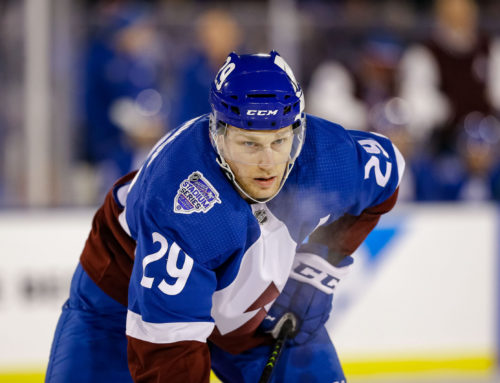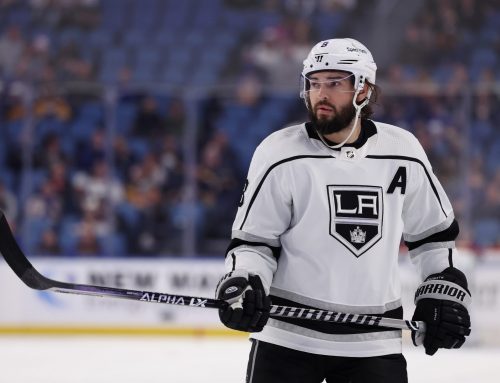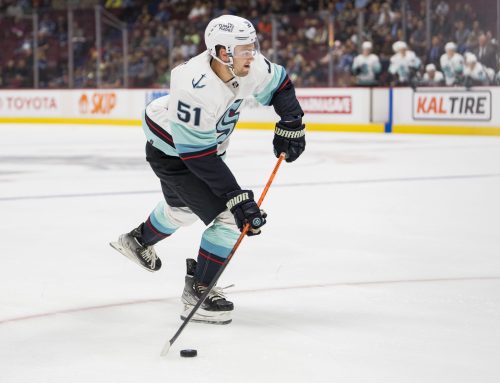Wild West Summer Series 2019: Nashville
Chris Kane
2019-08-12

Welcome to week ten of our summer series. Like last season, this series is intended to take a look at the teams in the Western Conference one by one. We will do a short recap of what took place, but the deep dive here will be into the players that helped make it so, for better or worse. We will be taking a look at a few players who out or under performed their expectations and be considering whether this performance might just be the new normal.
And now for the technical details. We will be using the Fantasy Hockey Geek tool to get a ranking that combines all of a player’s stats for the searched categories. These ranks are based on a 12 team, head-to-head league, using the categories of goals, assists, power-play points, shots, hits and blocks for forwards/defensemen and wins, saves, save percentage and goals against average for goalies. The idea is to compare this ranking with an expected ranking based on the average draft positions from the start of the year. This process does not necessarily identify who was the most important player to each team but gives us not only an idea of who was a steal/bust on draft day, but where each player was valued going into this season. Player eligibility for this series is based on Yahoo, and draft ranks are based on average draft positions compiled from Yahoo, ESPN and CBS by FantasyPros.
This week: Nashville
Recap:
Nashville finished first in the Central Division, and third in the west with 100 points. They had the third fewest goals against in the league, but unfortunately were ousted in the first round by upstart Colorado. Bringing in Mikael Granlund at the end of 2018-19 and Matt Duchene from free agency gives Nashville a new look top six for 2019-20 and hopes to improve 2018-19’s abysmal power play.
Undervalued:
Ekholm was drafted at 168th in 2018-19. That amounts to about someone’s 4th defensemen in a 12 team league. With a career high of 35 points it isn’t exactly surprising that he was a low pick – it may actually be more surprising that he was drafted near Jeff Petry, Cam Fowler, and Duncan Keith. By the end of the season his value definitely increased and he finished the season ranked 138th overall.
|
Player |
Team |
Position |
FHG Rank |
|
NJD |
D |
135 |
|
|
NYI |
D |
137 |
|
|
NSH |
D |
138 |
|
|
COL |
D |
139 |
|
|
NYR |
D |
140 |
He did not finish among elite company, but certainly provided excellent value for his drafting place.
|
GP |
Goals |
Assists |
Points |
Points/ Game |
Shots |
S% |
Hits |
PPPts |
Blocks |
PPTOI |
TOI |
|
80 |
8 |
36 |
44 |
0.55 |
146 |
5.5 |
68 |
7 |
107 |
1:22 |
23:22 |
It is not terribly difficult to see why he increased in value. His 44 points is clearly a career high. That difference makes up for essentially all of the gains in value he made during the season. He had a few more shots, but a few less hits and blocks.
The bigger question is how did Ekholm suddenly manage a 10 point increase in total points? He had roughly the same total time on ice, and power-play time. He didn’t end up with more goals than usual, even though he had more shots. He didn’t increase his power-play point numbers. In fact both his goal numbers and power-play numbers are down from 2017-18. The big gain then seems to have come from even strength assists. Where did those come from? As just stated, he did not have more time on ice – so no real change in opportunity, and his teammates were not more productive while he was on the ice. His team five-on-five shooting percentage was actually a little down from 2017-18. The big change was Ekholm’s IPP. He was up around 49% when over the last five seasons he has averaged about 32%.
So what about 2019-20? Ekholm’s increase in value for 2018-19 seems to have come from a likely unsustainable bump in IPP. Unless Ekholm’s usage or linemates dramatically changed during 18-19 (and it doesn’t look like they did) a gain of that magnitude would be considered an outlier and we would expect it to regress back to his average. The one outstanding question is what to the Predators do now that P.K. Subban is out of the lineup. Subban was Ekholm’s most common line mate at even strength.
When Subban was out of the lineup in November and December (of 2018) Ekholm’s most common linemate was Dan Hamuis, which is certainly not an upgrade if we are hoping for offensive production when Ekholm is on the ice. Ekholm’s time on ice numbers did not change during that time period so he did not get a bump in power-play opportunity or anything like that. Interesting though he did get 11 of his assists during that time period and his IPP was up at 55%. It is an incredibly small sample, but it might imply that Ekholm has a chance to play a slightly more offensive role in his pairing without Subban in the lineup. We do also need to consider the chance that Subban’s absence long term makes Nashville shake up their parings. Overall though I have a hard time seeing Subban’s departure as a real benefit to Ekholm. If he were to get an additional power-play role that would change things, but the addition of Matt Duchene in the offseason makes that seem very unlikely.
Ekholm’s 2018-19 season was a career best, but looks largely unsustainable. Best case he gets more time on ice, or a slightly more offensive role with Subban out of the picture, but 40 points seems a likely ceiling. He will again be a solid 4th defensive option, but I wouldn’t be drafting him higher than that.
Overvalued:
Eeli Tolvanen:
Tolvanen had a fair amount of optimism behind him going into 2018-19. His 2017-18 season was essentially nonexistent as he played only two games in the NHL, but his international season and prospect report indicated he was still highly valued. He was drafted 240th overall, so generally at the very end of most deeper leagues. By the end of the season he was the 909th ranked player. While it is hard to say that any team’s last player is over-valued, he was drafted by enough teams that managers clearly were hoping for some sort of production from him. Unfortunately they literally got next to nothing.
If we are being exceedingly generous we could say he scored a 50 point pace, but the reality is he only saw ice time in four games (a current career high). This sample size is clearly too small to draw any kind of analysis from on the score sheet, but we can notice that he was playing just over 13 minutes a night and he was seeing time with Calle Jarnkrok and Craig Smith.
|
GP |
Goals |
Assists |
Points |
Points/ Game |
Shots |
S% |
Hits |
PPPts |
Blocks |
PPTOI |
TOI |
|
4 |
1 |
1
📢 advertisement:
|
2 |
0.5 |
2 |
50 |
4 |
1 |
2 |
1:27 |
13:16 |
His AHL season wasn’t spectacular either (35 points in 58 games). If we take a look at Dobber Prospects’ NHL equivalence chart for Tolvanen we see a dramatic fall off in 2018-19 to the point where we are seeing a potential star in the league dropping to a player with borderline second line potential. All of this obviously comes with a significant grain of salt, but the fall off is pretty alarming.
For 2019-20 it is very unlikely that most leagues will be drafting Tolvanen. He was a borderline guy in deeper formats when the prospect reports were indicating he could be a future star, but now after a difficult transition to North American hockey, there are some significant question marks.
To make matters worse it is hard to see where in the lineup Tolvanen would slot in. Viktor Arvidsson is virtual guarantee on the top line and a couple of weeks ago we took a look at Craig Smith and made the case that he is likely pick for the second line. Mikael Granlund could very easily slot in on the right side as well. That leaves Tolvanen competing with Autism Watson for some bottom six time, and at best bottom six production.
Overall the expectations for Tolvanen have certainly cooled, which in some cases may represent a good buy low window. In this case though waiting to see if he earns an opportunity, and makes something out of it seems wise.
Turris came into 2018-19 riding two reasonably strong seasons (55ish point paces) and some good chemistry on the second line. He was drafted 220th overall, right ahead of Noah Hanafin and Thomas Chabot. By the end of the season he was ranked 612th surrounded by a number of equally fantasy irrelevant players.
|
Carl Dahlstrom |
CHI |
D |
610 |
|
DAL |
RW |
611 |
|
|
NSH |
C |
612 |
|
|
COL |
LW/RW |
613 |
|
|
Mario Kempe |
ARI |
C/RW |
614 |
Part of the issue was certainly the fact that Turris played only 55 games. That is down from his previous couple of seasons where he played 76 (side note Turris has only played 82 games twice – 2013-15 in Ottawa).
|
GP |
Goals |
Assists |
Points |
Points/ Game |
Shots |
S% |
Hits |
PPPts |
Blocks |
PPTOI |
TOI |
|
55 |
7 |
16 |
23 |
0.42 |
78 |
9 |
24 |
6 |
15 |
2:14 |
15:42 |
The issue wasn’t just his games played though, Turris saw his lowest point per game numbers since 2010-11 for Phoenix. In fact 2018-19 saw him post recent career lows in a number of categories. He had his lowest average time on ice since 2011-12, and it has been declining steadily since 2015-16 over two different teams. He also saw his lowest average power-play time since 2011-12. His shot pace was his lowest of his career (minus his rookie season where he played only three games). On the potentially positive side, his shooting percentage was the lowest since 2011-12, and his team five on five shooting percentage was the lowest that we have on record (data goes back to 2011-12).
In plain terms that means his fall from expectation was due to a drop in point production likely due, at least in part, to losses in time on ice, and in some cases variance in his or his teammate’s performance. Turris was good in the first quarter playing with Craig Smith and Kevin Fiala. That trio had been decent in 2017-18 as well. Unfortunately by the end of the second quarter saw Turris entered a tailspin that he never recovered from. His point production dried up, his linemates got shifted around and by the end of the season he had three points over his final 16 games.
So what do we do with Turris for 2019-20? Frankly, the answer seems to be not much. It is true that his personal and team shooting percentages were low and that in a perfect world Turris playing the same season again would have resulted in more points. Over the last five season Turris has averaged .616 points per game, or a 50 point pace. That came with an average 2:45 of power-play time and over 18 minutes of total time. In my book then a 50 point pace seems totally reasonable if he can get that kind of deployment. Unfortunately by the end of 2018-19 he was seeing just over 15 minutes of total time and about a minute on the power play. The news doesn’t get better either as it is hard to see a spot for Turris on either of the top two lines. Adding Duchene pushes Turris to a 3C role, or in competition for a wing spot with Craig Smith, and Granlund. That isn’t a recipe for 18 minutes or strong power-play role. 40 points seems a much more reasonable expectation at this point.
Thanks for reading
Next week: Philadelphia
Previous Team Articles:





 CAR
CAR NYI
NYI BOS
BOS TOR
TOR MTL
MTL T.B
T.B COL
COL VAN
VAN VGK
VGK EDM
EDM MIN
MIN
